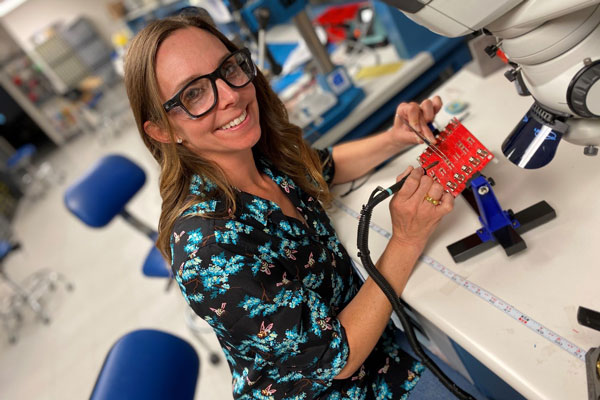Sandia renewable and distributed systems integration engineer recognized by DOE STEM Rising site

Sandia civil engineer Brooke Marshall Garcia has been recognized by DOE’s Women @ Energy: STEM Rising website, which honors women in STEM fields throughout the DOE complex.
As a civil engineer, Brooke has always enjoyed applying her math skills to address water management challenges. After several years as a private consultant in water resource management, she obtained an MBA from the University of New Mexico and began working at Sandia as a technology transfer professional, leveraging intellectual property developed by the Labs to benefit the U.S. economy.
During her time at Sandia, Brooke has been involved in research, including grid resiliency, neutron generator production, mechanical processes and supply chain development.
Embracing lifelong learning and her passion for energy studies, Brooke is studying at Johns Hopkins University for a master’s degree in energy policy and climate. She provides her dedication to service through a multifaceted approach to addressing technical problems. Brooke models this approach for other women through her participation in the Sandia Women’s Action Network and co-mentoring with a group of women at Sandia.
Brooke was interviewed recently for her feature spot on the DOE Women @ Energy website.
Describe your current role at Sandia. What is the main purpose and mission of your work?
As an engineer in the Renewable and Distributed Systems Integration team at Sandia, I look at ways to improve the electric grid. This includes addressing a broad range of energy challenges such as integrating renewable energy sources and making communities more energy resilient.
Energy, to me, is the single most important part of our national infrastructure. My mission and purpose in this work is to influence a future that enjoys reliable, resilient energy without causing climate instability or polluting the environment.
What inspired you to work in STEM?
Growing up, aptitude-wise, math and science were my best subjects. We moved around a lot and I found stability and continuity in the math curriculum. I have always loved literature and art, languages and culture, but math held a special sturdiness to it. I started my undergraduate degree thinking I would pursue physics, but as I moved through the curriculum, I shifted to mechanical engineering before ultimately becoming a civil engineer. Civil engineering brought the opportunity to analyze and build things, as well as to study and protect the environment.
What excites you about your work?
There are seemingly infinite opportunities across the DOE laboratory complex to contribute to solving important challenges. I worked in nuclear deterrence prior to joining the RDSI group in January 2020. Before that, I worked in water resources and technology transfer.
The common theme in my career is one of public service motivated by the chance to improve societal stability. At this stage of my life and career, I have come to believe that energy is the single greatest contributor to societal stability. And this reality is only growing in magnitude. Power generation, transmission, distribution and resilience are, collectively, among the most urgent challenges facing humanity today. I am proud of any contribution I can make to a more sustainable, secure, modern electric grid. I get up every day knowing that my efforts may improve the future for my kids and for future generations.
How can our country engage more women, girls and other underrepresented groups in STEM?
This is an interesting challenge. The current demographics are an inheritance of age-old, systemic inequities that can take generations to recognize, let alone to overcome. Tenacity in encouraging future scientists of all kinds is key. We must look for biases and stereotypes and actively question the norms we have taken for granted; always remembering to ask why. And we need to continue to remove barriers and dispel misconceptions.
STEM is not one thing; it is many things. The truth is, there are unlimited versions of a STEM career. STEM allows a person to develop into their passions with tools that remain valuable no matter where your career takes you.
If I could tell the young women and other underrepresented people interested in this field one thing, it would be this: STEM means embracing your curiosity, following your interests, and working to further collective understanding. It is not a box into which you must fit yourself. It is not predefined. It is a wide-open field needing smart, passionate, inspired people to define it. Do not be dissuaded by preconceptions; define the profession for yourself.
Do you have tips you’d recommend for someone looking to enter your field of work?
Work hard. Make it your own. You will be glad you did. There is so much left to discover and understand. If you have the aptitude and curiosity to follow a STEM path, don’t allow demographics to dissuade you. The field is open and welcoming to people of all kinds. Keep working until you find your niche. We need women not to fit into something that already exists — we need women to help shape the future.
When you have free time, what are your hobbies?
I love spending time with my friends and family. I love to read and philosophize. I love music and poetry. I’m a runner and yogini. I ski and golf (badly). I love to cook for others, and I’m a proud mama and wife. I am a dreamer, optimist and adventurer.